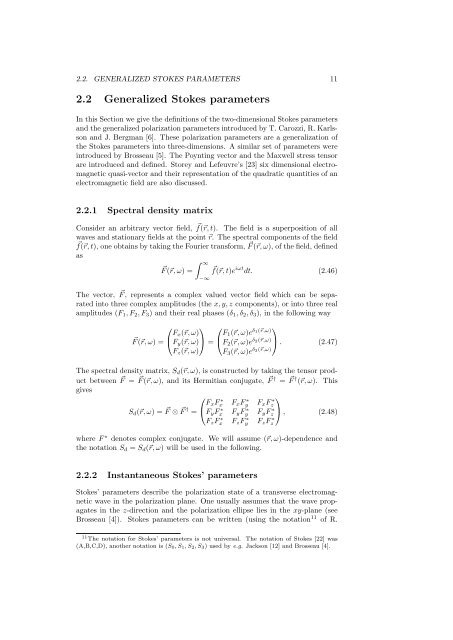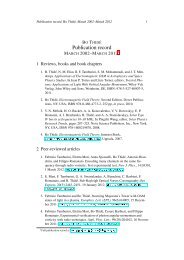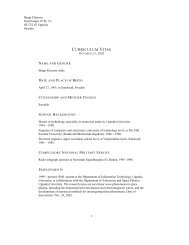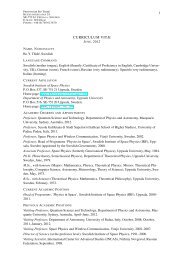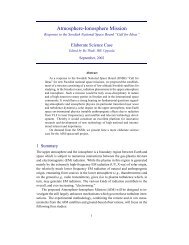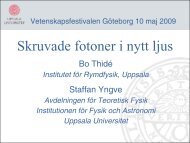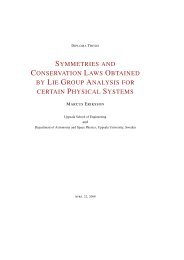Towards a covariant formulation of electromagnetic wave polarization
Towards a covariant formulation of electromagnetic wave polarization
Towards a covariant formulation of electromagnetic wave polarization
You also want an ePaper? Increase the reach of your titles
YUMPU automatically turns print PDFs into web optimized ePapers that Google loves.
2.2. GENERALIZED STOKES PARAMETERS 11<br />
2.2 Generalized Stokes parameters<br />
In this Section we give the definitions <strong>of</strong> the two-dimensional Stokes parameters<br />
and the generalized <strong>polarization</strong> parameters introduced by T. Carozzi, R. Karlsson<br />
and J. Bergman [6]. These <strong>polarization</strong> parameters are a generalization <strong>of</strong><br />
the Stokes parameters into three-dimensions. A similar set <strong>of</strong> parameters were<br />
introduced by Brosseau [5]. The Poynting vector and the Maxwell stress tensor<br />
are introduced and defined. Storey and Lefeuvre’s [23] six dimensional <strong>electromagnetic</strong><br />
quasi-vector and their representation <strong>of</strong> the quadratic quantities <strong>of</strong> an<br />
<strong>electromagnetic</strong> field are also discussed.<br />
2.2.1 Spectral density matrix<br />
Consider an arbitrary vector field, ⃗ f(⃗r, t). The field is a superposition <strong>of</strong> all<br />
<strong>wave</strong>s and stationary fields at the point ⃗r. The spectral components <strong>of</strong> the field<br />
⃗f(⃗r, t), one obtains by taking the Fourier transform, ⃗ F (⃗r, ω), <strong>of</strong> the field, defined<br />
as<br />
⃗F (⃗r, ω) =<br />
∫ ∞<br />
−∞<br />
⃗f(⃗r, t)e iωt dt. (2.46)<br />
The vector, ⃗ F , represents a complex valued vector field which can be separated<br />
into three complex amplitudes (the x, y, z components), or into three real<br />
amplitudes (F 1 , F 2 , F 3 ) and their real phases (δ 1 , δ 2 , δ 3 ), in the following way<br />
⎛<br />
⃗F (⃗r, ω) = ⎝ F ⎞ ⎛<br />
⎞<br />
x(⃗r, ω) F 1 (⃗r, ω)e δ1(⃗r,ω)<br />
F y (⃗r, ω) ⎠ = ⎝F 2 (⃗r, ω)e δ2(⃗r,ω) ⎠ . (2.47)<br />
F z (⃗r, ω) F 3 (⃗r, ω)e δ3(⃗r,ω)<br />
The spectral density matrix, S d (⃗r, ω), is constructed by taking the tensor product<br />
between F ⃗ = F ⃗ (⃗r, ω), and its Hermitian conjugate, F ⃗ † = F ⃗ † (⃗r, ω). This<br />
gives<br />
⎛<br />
⎞<br />
S d (⃗r, ω) = F ⃗ ⊗ F ⃗ F x F † x ∗ F x Fy ∗ F x Fz<br />
∗<br />
= ⎝F y Fx ∗ F y Fy ∗ F y Fz<br />
∗ ⎠ , (2.48)<br />
F z Fx ∗ F z Fy ∗ F z Fz<br />
∗<br />
where F ∗ denotes complex conjugate. We will assume (⃗r, ω)-dependence and<br />
the notation S d = S d (⃗r, ω) will be used in the following.<br />
2.2.2 Instantaneous Stokes’ parameters<br />
Stokes’ parameters describe the <strong>polarization</strong> state <strong>of</strong> a transverse <strong>electromagnetic</strong><br />
<strong>wave</strong> in the <strong>polarization</strong> plane. One usually assumes that the <strong>wave</strong> propagates<br />
in the z-direction and the <strong>polarization</strong> ellipse lies in the xy-plane (see<br />
Brosseau [4]). Stokes parameters can be written (using the notation 11 <strong>of</strong> R.<br />
11 The notation for Stokes’ parameters is not universal. The notation <strong>of</strong> Stokes [22] was<br />
(A,B,C,D), another notation is (S 0 , S 1 , S 2 , S 3 ) used by e.g. Jackson [12] and Brosseau [4].


